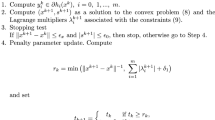Abstract
This paper is concerned with the problem of secure transmission for amplify-and-forward multi-antenna relay systems in the presence of multiple eavesdroppers. Specifically, spatial beamforming and artificial noise broadcasting are chosen as the strategy for secure transmission with robustness against imperfect channel state information of the intended receiver and the eavesdroppers. In such a scenario, the objective is to maximize the worst-case secrecy rate while guaranteeing the transmit power constraint at the relay and the norm-bounded channel uncertainty. We reformulate the problem as a general DC (Difference-of-Convex functions) program (i.e. minimizing a DC function under DC constraints) and develop a very inexpensive DCA based algorithm for solving it. Numerical results illustrate the effectiveness of the proposed algorithm and its superiority versus the existing approach.
Access this chapter
Tax calculation will be finalised at checkout
Purchases are for personal use only
Similar content being viewed by others
References
Kumar, S., Paar, C., Pelzl, J., Pfeiffer, G., Ruppp, A., Schimmler, M.: How to break DES for euro 8,980. In: Workshop on Special purpose Hardware for Attacking Cryptographic Systems – SHARCS 2006, Colgne, Germany (2006)
Li, Q., Song, H., Huang, K.: Achieving secure transmission with equivalent multiplicative noise in MISO wiretap channels. IEEE Commun. Lett. 17(5), 892–895 (2013)
Wyner, A.D.: The wire-tap channel. Bell Syst. Tech. J. 54(8), 1355–1387 (1975)
Leung-Yan-Cheong, S., Hellman, M.E.: The Gaussian wiretap channel. IEEE Trans. Inf. Theory 24(7), 451–456 (1978)
Zou, Y., Wang, X., Shen, W.: Eavesdropping attack in collaborative wireless networks: security protocols and intercept behavior. In: Proceedings of the 17th IEEE International Conference on Computer Supported Cooperative Work in Design, Whistler, Canada, pp. 704–709 (2013)
Zhang, J., Gursoy, M.: Collaborative relay beamforming for secrecy. In: Proceedings of the IEEE Wireless Communication Symposium (ICC), Cape Town, South Africa, pp. 1–5 (2010)
Jeong, C., Kim, I., Dong, K.: Joint secure beamforming design at the source and the relay for an amplify-and-forward MIMO untrusted relay system. IEEE Trans. Signal Process. 60(1), 310–325 (2012)
Mukherjee, A., Swindlehurst, A.: Robust beamforming for security in MIMO wiretap channels with imperfect CSI. IEEE Trans. Signal Process. 59(1), 351–361 (2011)
Goel, S., Negi, R.: Guaranteeing secrecy using artificial noise. IEEE. Trans. Wireless Commun. 7(6), 2180–2189 (2008)
Li, Q., Yang, Y., Ma, W.K., Lin, M., Ge, J., Lin, J.: Robust cooperative beamforming and artificial noise design for physical-layer secrecy in AF multi-antenna multi-relay networks. IEEE Trans. Signal Process. 63(1), 206–220 (2015)
Zhang, C., Gao, H., Liu, H., Lv, T.: Robust beamforming and jamming for secure AF relay networks with multiple eavesdroppers. In: IEEE Military Communications Conference (MILCOM), pp. 495–500 (2014)
Zhang, L., Jin, L., Luo, W., Tang, Y., Yu, D.: Robust joint beamforming and artificial noise design for amplify-and-forward multi-antenna relay systems. In: IEEE Speech and Signal Processing (ICASSP), pp. 1732–1736 (2015)
Pham Dinh, T., Le Thi, H.A.: Convex analysis approach to DC programming: theory, algorithms and applications. Acta Mathematica Vietnamica 22, 289–355 (1997)
Pham Dinh, T., Le Thi, H.A.: DC optimization algorithms for solving the trust region subproblem. SIAM J. Optim. 8, 476–505 (1998)
Pham Dinh, T., Le Thi, H.A.: The DC (difference of convex functions) programming and DCA revisited with DC models of real world non convex optimization problems. Ann. Oper. Res. 133, 23–46 (2005)
Le Thi, H.A., Huynh, V.N., Pham Dinh, T.: DC Programming and DCA for General DC Programs. In: van Do T., Thi H., Nguyen N. (eds) Advanced Computational Methods for Knowledge Engineering. Advances in Intelligent Systems and Computing, pp. 15–35 (2014)
Pham Dinh, T., Le Thi, H.A.: Recent advances in DC programming and DCA. Trans. Comput. Intell. 13, 1–37 (2014)
Le Thi, H.A., Pham Dinh, T.: DC programming and DCA: thirty years of developments. Math. Program. 169(1), 5–68 (2018). Special Issue: DC Programming - Theory, Algorithms and Applications
Grant, M., Boyd, S: CVX: Matlab software for disciplined convex programming, version 2.0 (2012). http://cvxr.com/cvx
Author information
Authors and Affiliations
Corresponding author
Editor information
Editors and Affiliations
Rights and permissions
Copyright information
© 2018 Springer Nature Switzerland AG
About this paper
Cite this paper
Nguyen, P.A., Le Thi, H.A. (2018). A DC Programming Approach for Worst-Case Secrecy Rate Maximization Problem. In: Nguyen, N., Pimenidis, E., Khan, Z., Trawiński, B. (eds) Computational Collective Intelligence. ICCCI 2018. Lecture Notes in Computer Science(), vol 11055. Springer, Cham. https://doi.org/10.1007/978-3-319-98443-8_38
Download citation
DOI: https://doi.org/10.1007/978-3-319-98443-8_38
Published:
Publisher Name: Springer, Cham
Print ISBN: 978-3-319-98442-1
Online ISBN: 978-3-319-98443-8
eBook Packages: Computer ScienceComputer Science (R0)




